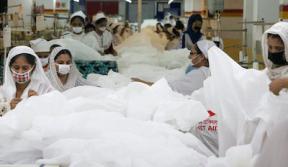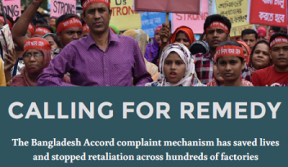Over 600 garment workers have been killed in garment factories in Bangladesh during the past six years while sewing clothing destined for North America and Europe. The September 11, 2012, garment factory blaze in Karachi, Pakistan – which killed 289 workers, making it the world’s deadliest industrial accident on record – is the latest reminder of the urgency by which brands must adopt proper safety measures to protect workers’ lives.
Since the December 14, 2010, fire which killed 29 workers at That’s It Sportswear, a factory in Bangladesh owned by the Hameem group that supplied Abercrombie & Fitch, Carter’s, Gap, JC Penney, Kohl’s, PVH Corp. (owner of Tommy Hilfiger, Calvin Klein, Izod and other brands), and Target, the International Labor Rights Forum and the Worker Rights Consortium have been part of a coalition urging apparel brands to ensure safety for workers in their supply chains. Nearly two years later, most of these companies are still not upholding their responsibility to workers. In March, when PVH announced its participation in a groundbreaking fire and building safety initiative in Bangladesh, Gap told ABC News that it would also take steps to improve conditions at its Bangladesh supplier factories. Six months later, Gap has yet to take meaningful action, even while Tchibo – a German retailer with stores in eleven countries – has just announced that it is joining in the safety program.
The International Labor Rights Forum and the Worker Rights Consortium are pointing to the failings of corporations’ current auditing efforts and are drawing attention to the need for more independent, robust building safety programs that include oversight by worker organizations and enable workers to identify and speak up about risks without fear of losing their jobs.
“Just weeks before the fire, SAI auditors certified Ali Enterprises as an exemplary workplace in compliance with applicable laws and worker protections. As reports from survivors have made clear, the brutal and dangerous conditions at the factory should have been obvious to any honest observer. It is impossible to imagine any clearer illustration of the bankruptcy of corporate-controlled factory monitoring schemes like SAI,” said Scott Nova, Executive Director of the Worker Rights Consortium.
Garib & Garib, a Bangladeshi factory that sewed clothes for H&M, had fires on four separate occasions during 2009-2010, killing a total of 33 workers, even while it was certified by WRAP (Worldwide Responsible Accredited Production), another corporate social responsibility scheme. After the August 2009 fire, H&M’s own inspectors visited and reported they had found nothing remarkable in the audit—nothing about inadequate firefighting equipment, lack of emergency exits, or absence of smoke detectors. And yet, fires took place at the factory again in February and April of 2010.
“It is time for the brands to put workers’ lives ahead of brand image, and promote real solutions. Before even more workers are burned alive while sewing clothing for export, apparel brands and retailers must uphold their responsibility by adopting a fire and building safety program that includes safety training, compliance with building codes, transparent and independent inspections, fair pricing, and a positive atmosphere for trade unions. These are the essential ingredients to preventing future disasters in the global apparel industry,” said Judy Gearhart, Executive Director of the International Labor Rights Forum.

